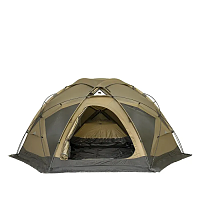Cart
Choosing the Best Location for Winter Tent Camping
Winter camping can be a breathtaking and rewarding experience for outdoor enthusiasts who are prepared to embrace the cold. However, finding the right location for winter tent camping is crucial to ensure safety, comfort, and an enjoyable adventure. In this comprehensive guide, we will explore the key factors to consider when selecting a winter camping location, allowing you to make an informed decision and have a memorable winter camping experience.
1. Consider the Climate: Embrace the Cold, but Beware of Extreme Conditions
Before choosing a location for winter tent camping, it's essential to consider the climate of the area you plan to visit. Embracing the cold is part of the winter camping experience, but extreme weather conditions can pose significant risks. Look for regions with milder winter climates, where temperatures are manageable and not prone to sudden drops. Additionally, check weather forecasts and be aware of any potential storms or extreme conditions that may impact your camping trip.
2. Accessibility and Proximity: Balance Adventure with Convenience
Accessibility and proximity to amenities are crucial factors to consider when choosing a winter camping location. While remote and secluded sites offer a serene and immersive experience, they may require more effort to reach and lack basic facilities. If you are a beginner or prefer a more convenient camping experience, look for campsites that provide easy access to parking, restrooms, and nearby towns where you can stock up on supplies. Strike a balance between adventure and convenience based on your comfort level and camping goals.
3. Safety First: Evaluate Potential Hazards and Risks
Safety should be a top priority when selecting a winter camping location. Evaluate potential hazards and risks associated with the area. Consider the terrain, including steep slopes, avalanche-prone zones, and the presence of frozen bodies of water. Look for campsites away from potential hazards, and if you plan to camp in an area prone to avalanches, ensure you have the necessary knowledge, equipment, and training to mitigate risks. It's also advisable to inform someone about your camping plans and expected return date.
4. Shelter from the Elements: Seek Natural Windbreaks and Protection
Finding a location that offers natural windbreaks and protection from the elements is essential in winter camping. Look for areas with trees, rock formations, or natural barriers that can act as windbreaks and provide some shelter. These features can significantly reduce the impact of strong winds and help maintain a more comfortable camping environment. Additionally, consider the orientation of your tent in relation to the prevailing winds, positioning it to maximize protection and minimize exposure.
5. Water Sources: Access to Freshwater and Ice Fishing Opportunities
Access to freshwater is crucial for any camping trip, including winter camping. Look for campsites near natural water sources such as lakes, rivers, or streams. These water sources not only provide hydration but also offer opportunities for ice fishing if permitted and within safety guidelines. Remember to pack appropriate water filtration or purification systems to ensure a safe and reliable water supply during your winter camping adventure.
6. Scenic Beauty and Winter Activities: Enhancing the Experience
Choosing a winter camping location that offers scenic beauty and opportunities for winter activities can enhance your overall experience. Look for areas with stunning winter landscapes, such as snow-capped mountains, frozen waterfalls, or picturesque valleys. Research the availability of activities like cross-country skiing, snowshoeing, or winter hiking nearby. These activities allow you to immerse yourself in nature's wonders and make the most of your winter camping trip.
7. Local Regulations and Permits: Adhere to Guidelines and Restrictions
Before finalizing your winter camping location, familiarize yourself with local regulations and permits. Different regions may have specific rules regarding camping, open fires, and wilderness use during winter months. Ensure you are aware of any restrictions or permit requirements to avoid legal issues and respect the environment. Check with local park authorities or land management agencies for up-to-date information and guidelines.
8. Leave No Trace: Preserve the Wilderness for Future Generations
- Contact Us
-

About Pomoly
Pomoly is a leading camping brand specializing in hot tents and tent stoves. We are camping life explorer, Follow Page / Join Group, let's make camping enjoyful together!
Working Hours
Mon-Fri, 09:00 - 17:00

- Company Info
- NEWS
- About us
- Pomoly Name
- Leave-No-Trace
- Contact Now
- Facebook Group
- YouTube Learning
- Contact Us
- Topic Collections
- Policies & Terms
- Payment Policy
- Shipping Policy
- Return & Refund
- Privacy Policy
- Terms of Use
- Tax Policy
- Website Disclaimer
- Safety Disclaimer
- Warranty Policy
- Promotion Policy
- Pre-order Policy
- INTELLECTUAL PROPERTY RIGHTS
- Dealers Agreement And Terms
- Become Affiliate
- User Center
- Forget Password
- My Orders
- Tracking Order
- My Account
- Register
- Popular Searches
-
Tipi Tents Dome Tents Camping Tent Hammock Stove Camping Camping Pellet Stove Circle 6 Titanium Water TankDome X Locomotive 20 LEO 2 camping tent T-Brick 2.0 T1 2.0 tent stove Dweller wood stove Oroqen 2.0 Chimney Water Tank Lumberjack STOVEHUT Bromance 70 Tipi Pomoly Coupon Baker Oven Stove Titanium elbow Fire Pits Tent Stove titanium Stove Outdoor Pellet Stove
keebon pellet stove






